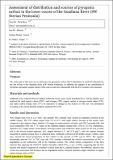Por favor, use este identificador para citar o enlazar a este item:
http://hdl.handle.net/10261/115132COMPARTIR / EXPORTAR:
 SHARE SHARE
 CORE
BASE CORE
BASE
|
|
| Visualizar otros formatos: MARC | Dublin Core | RDF | ORE | MODS | METS | DIDL | DATACITE | |

| Título: | Assessment of distribution and sources of pyrogenic carbon in the lower course of the Guadiana River (SW Iberian Peninsula) |
Autor: | Rosa Arranz, José M. de la; Martins, J. M.; Soares, Antonio M.; Araújo, María Fátima | Palabras clave: | Soot Refractory organicmatter Recent sediments Estuaries CTO-375 method Black carbon |
Fecha de publicación: | 2015 | Editor: | Springer Nature | Citación: | Journal of Soils and Sediments 15: 759- 768 (2015) | Resumen: | © 2015, Springer-Verlag Berlin Heidelberg. Purpose: The main goal of this work was to determine the pyrogenic carbon (PyC) distribution in surficial sediments for the last 40 km of the Guadiana River (SW Iberian Peninsula). In addition, the changes in the contribution of terrestrial and marine organic matter (OM) sources and their relationship with the PyC contents were assessed. Materials and methods: Sediments were collected from 22 stations within the lower course of the Guadiana River. All the samples were analyzed for total organic carbon (TOC), total nitrogen (TN), organic carbon to nitrogen atomic ratios (C/N), and stable carbon isotope ratio (δ13C) as indicators of changes in the sources of OM. PyC was determined according to the chemo-thermal oxidation method (CTO-375). Results and discussion: TOC ranged from 0.25 to 2.37 %dw. The greatest TOC contents were located in sediments collected at the middle estuary. The C/N values ranged from 7.7 to 12.7, with slight relative increase in the marine input compared to pre-Alqueva times. Similar C/N ranges are representative of native soil OM, lacustrine OM, and local sedimentary OM. The δ 13C values of the sediment samples ranged from –25.0 to –27.6 ‰ illustrating a signature of C3 higher plants, marsh-plants, lacustrine plants, and freshwater algae present in the area of study and in the forests located upstream. PyC ranged between 0.17 and 0.74 gkg−1, with the highest contents measured in samples located close to urbanized areas. Sediments collected at the middle estuary, within a rural area, showed the lowest proportions of PyC relative to the percent of TOC (≤4 % TOC). The negative relationship between PyC to TOC ratio and TOC contents confirmed the selective preservation of PyC to degradation in the sedimentary OM of the Guadiana estuary. The carbon isotope composition of the final material after applying the CTO-375 method (hereafter called δ13CPyC) was ˂–30 ‰, suggesting that the PyC fraction was mainly composed of a mixture of fossil fuels and C3-charred biomass. Nevertheless, selective loss of the less recalcitrant OM fractions due to degradation and/or chemical alteration might contribute to lighter carbon isotope values of PyC. Conclusions: Geochemical data showed that sedimentary OM was composed of a mix of different OM sources, with a slight increase in the marine input after the Alqueva dam went into operation. The PyC content was higher close to urbanized areas of the Guadiana River estuary. The selective preservation of PyC in the sedimentary OM of the Guadiana estuary was observed. | Descripción: | 10 páginas.-- 4 figuras.-- 1 tabla.-- 72 referencias | Versión del editor: | http://dx.doi.org/10.1007/s11368-015-1092-8 | URI: | http://hdl.handle.net/10261/115132 | DOI: | 10.1007/s11368-015-1092-8 | Identificadores: | doi: 10.1007/s11368-015-1092-8 issn: 1614-7480 |
| Aparece en las colecciones: | (IRNAS) Artículos |
Ficheros en este ítem:
| Fichero | Descripción | Tamaño | Formato | |
|---|---|---|---|---|
| Assessment_Journal_soils_sediments.pdf | 10,54 MB | Adobe PDF |  Visualizar/Abrir |
CORE Recommender
SCOPUSTM
Citations
3
checked on 27-mar-2024
WEB OF SCIENCETM
Citations
2
checked on 24-feb-2024
Page view(s)
302
checked on 22-abr-2024
Download(s)
309
checked on 22-abr-2024
Google ScholarTM
Check
Altmetric
Altmetric
NOTA: Los ítems de Digital.CSIC están protegidos por copyright, con todos los derechos reservados, a menos que se indique lo contrario.
